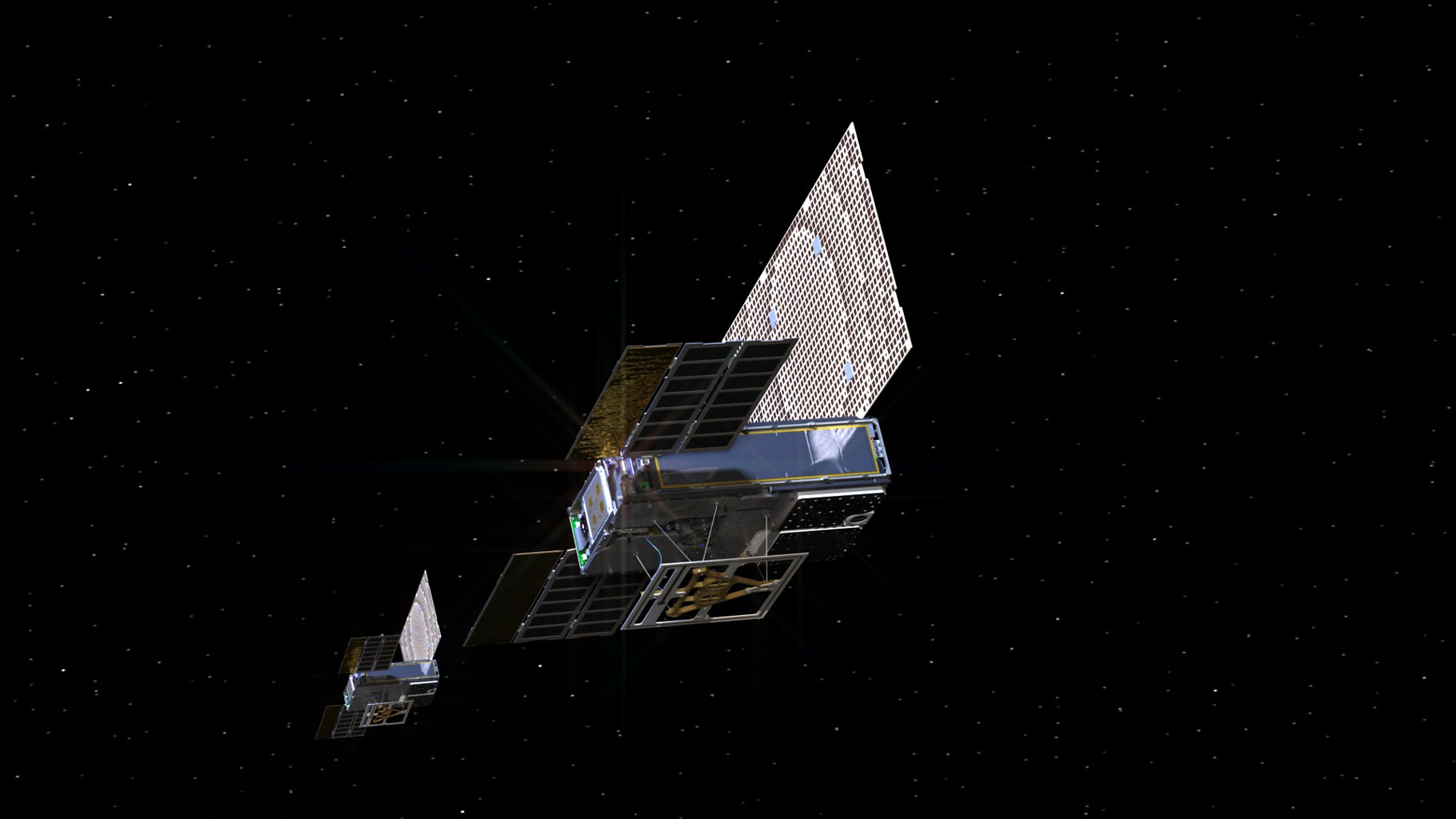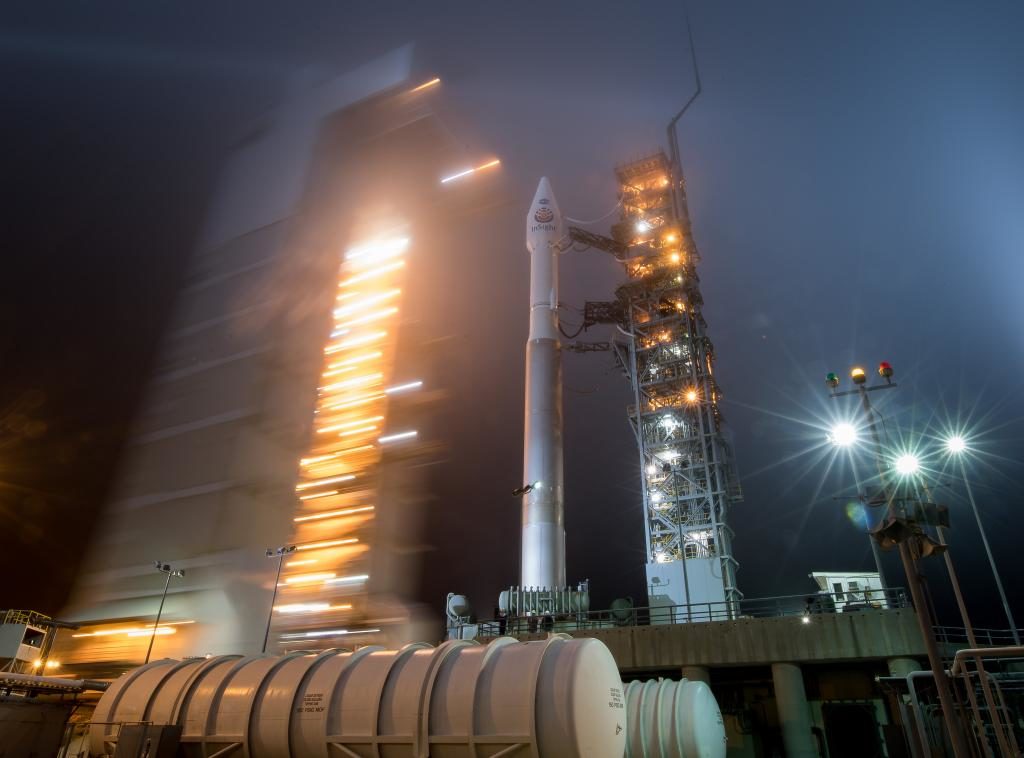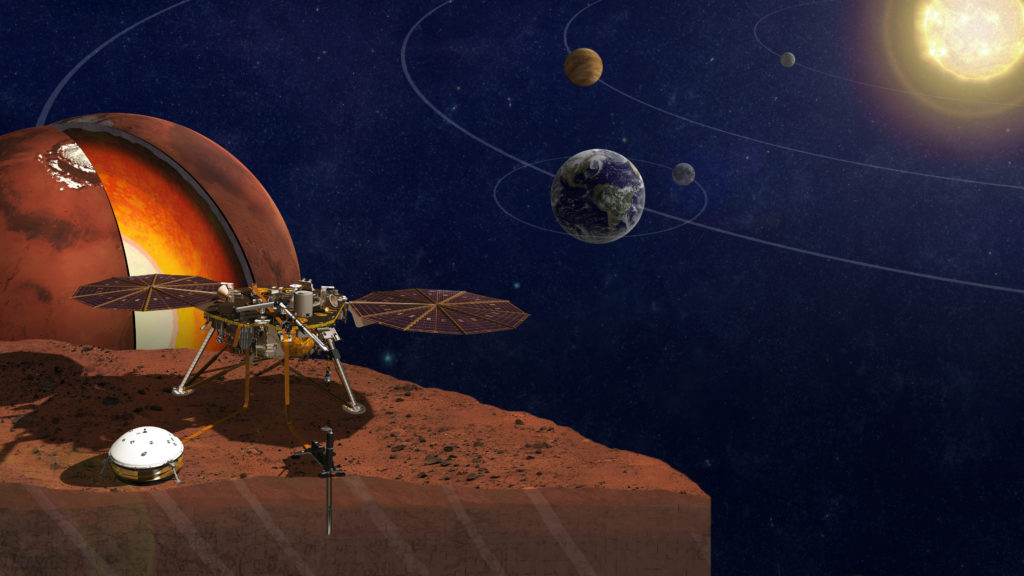The Centaur upper stage main engine has started its burn following on-time booster engine cutoff and Atlas/Centaur separation. The first of two burns for the Centaur main engine start will last nearly eight minutes. The payload fairing has been jettisoned.
Liftoff! Atlas V Clears the Launch Pad with NASA’s InSight Spacecraft

Booster ignition and liftoff of the United Launch Alliance Atlas V rocket at 7:05 a.m. EDT (4:05 a.m. PDT), from Space Launch Complex 3 at Vandenberg Air Force Base in California, carrying NASA’s InSight spacecraft. The rocket is on its way, carrying NASA’s Interior Exploration using Seismic Investigations, Geodesy and Heat Transport (InSight) to begin its six month voyage to Mars.
About four minutes into flight, a series of key events occurs in rapid succession: Atlas booster engine cutoff, separation of the booster from the Centaur upper stage, ignition of the Centaur main engine for its first of two burns, then jettison of the payload fairing.
T-4 Minutes and Counting
The InSight countdown is underway, proceeding toward a liftoff at 7:05 a.m. EDT (4:05 a.m. PDT). During the last four minutes of the countdown, the Atlas and Centaur propellant tanks will be brought up to flight pressure, the rocket and spacecraft will be confirmed on internal power, and the Western Range and launch managers will perform final status checks. A computerized autosequencer will take over the countdown in order to conduct a host of activities in precise order.
Mars Cube One Will Launch with NASA’s InSight Spacecraft

Hitching a ride with InSight is NASA’s technology experiment known as Mars Cube One (MarCO), a separate mission of its own. Designed and built by NASA’s Jet Propulsion Laboratory in Pasadena, California, MarCO consists of two mini-spacecraft and will be the first test of CubeSat technology in deep space. They are designed to test new communications and navigation capabilities for future missions and may provide real-time communication relay to cover the entry, descent and landing of InSight on Mars.
After InSight has separated from the Atlas V Centaur second stage, MarCO will launch one at a time from dispensers mounted on the aft bulkhead carrier of the second stage.
For more information about MarCo, visit http://www.jpl.nasa.gov/cubesat/missions/marco.php.
T-4 Minutes and Holding
The launch countdown has entered a planned T-4 minute hold. This hold will last 15 minutes. There are no weather constraints.
InSight Weather ‘Green’ For Launch
There are no weather constraints for launch this morning. Launch is targeted for 7:05 a.m. EDT (4:05 a.m. PDT), at the beginning of a two-hour launch window.
Atlas V Fueling Underway
Fueling of the United Launch Alliance Atlas V 401 rocket is underway.
NASA’s InSight Ready for Launch atop Atlas V Rocket

Good morning, and welcome to launch day for NASA’s Interior Exploration using Seismic Investigations, Geodesy and Heat Transport (InSight). The first-ever mission to study the heart of Mars, will launch on a United Launch Alliance Atlas V 401 rocket from Space Launch Complex 3 at Vandenberg Air Force Base in California. Launch is targeted for 7:05 a.m. EDT (4:05 a.m. PDT), at the beginning of a two-hour launch window.
Today’s launch blog originates from the NASA News Center here at Kennedy Space Center in Florida, so event times may be provided in both Eastern and Pacific. Follow the launch countdown and launch at https://www.nasa.gov/nasalive.
Workhorse Rocket to Launch NASA’s InSight Spacecraft on its Mission to Mars

The rocket standing ready on the pad at Space Launch Complex-3 at Vandenberg Air Force Base in California, is a United Launch Alliance Atlas V 401 configuration. It is the workhorse of the Atlas V fleet, delivering about half of all Atlas V missions to date.
The 401 designation means this rocket has a payload fairing, or nose cone, that is approximately four meters wide, a common core booster with no solid rocket boosters, and a Centaur upper stage with a single engine. Booster propulsion is provided by the RD-180 engine system, a single engine with two thrust chambers. The RD-180 burns Rocket Propellant-1 (RP-1), a highly purified kerosene, along with liquid oxygen, providing 860,200 pounds of thrust at liftoff.
The booster is controlled by the Centaur second stage avionics system, which provides guidance, flight control and vehicle sequencing functions during the booster and Centaur phases of flight. The single-engine Centaur upper stage is a cryogenic vehicle, fueled with liquid hydrogen and liquid oxygen. The two-piece payload fairing that protects the Insight spacecraft tops the vehicle.
The Atlas V 401 rocket stands 188 feet tall, or about as tall as a 19-story building. Fully stacked, with spacecraft, the rocket weighs about 730,000 pounds, or the equivalent of 14 big rigs fully loaded with cargo.
NASA’s InSight Spacecraft Will Explore Interior of Mars
 NASA’s Interior Exploration using Seismic Investigations, Geodesy and Heat Transport (InSight) will be the first interplanetary mission to take off from the West Coast. InSight is targeted to launch at 4:05 a.m. PDT (7:05 a.m. EDT) from Space Launch Complex-3 at Vandenberg Air Force Base in California aboard a United Launch Alliance Atlas V rocket.
NASA’s Interior Exploration using Seismic Investigations, Geodesy and Heat Transport (InSight) will be the first interplanetary mission to take off from the West Coast. InSight is targeted to launch at 4:05 a.m. PDT (7:05 a.m. EDT) from Space Launch Complex-3 at Vandenberg Air Force Base in California aboard a United Launch Alliance Atlas V rocket.
InSight is a NASA Discovery Program mission that will place a single geophysical lander on Mars to study its deep interior. The terrestrial planet explorer will open a window into the processes that shaped the rocky planets of the inner solar system (including Earth) more than 4.5 billion years ago. Using sophisticated geophysical instruments, InSight will address fundamental questions about the formation of Earth-like planets by detecting the fingerprints of those processes buried deep within the interior of Mars.
The InSight lander is equipped with two science instruments that will conduct the first “check-up” of Mars, measuring its “pulse,” or internal activity, along with its temperature and “reflexes,” or the way the planet wobbles when it is pulled by the Sun and its moons.
The science payload comprises two instruments: the Seismic Experiment for Interior Structure (SEIS), provided by the French Space Agency, with the participation of the Institut de Physique du Globe de Paris (IPGP), the Swiss Federal Institute of Technology, the Max Planck Institute for Solar System Research, Imperial College and the Jet Propulsion Laboratory. The second instrument, the Heat Flow and Physical Properties Package (HP3), is provided by the German Space Agency. Also, the Rotation and Interior Structure Experiment (RISE), led by JPL, will use the spacecraft communication system to provide precise measurements of planetary rotation.
InSight’s lander will spend two years investigating the deep interior of Mars. For more information visit the InSight mission overview.
